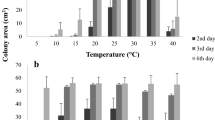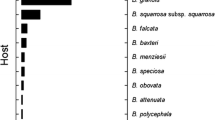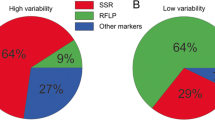Abstract
Isolates ofTyphula incarnata, a snow mold fungus, were collected from four localities with different winter climates. Their ecological traits such as mycelial growth rate, sclerotium size, carpogenic germination of sclerotia, and aggressiveness were compared between populations in order to reveal infraspecific differentiation associated with climatic differences. Population variability was evident only in sclerotium germination: isolates from more snowy localities germinated faster than those from less snowy localities.T. incarnata is regarded as a versatile pathogen with no specialized forms in contrast withT. ishikariensis. The germination rate of sclerotia is considered very critical in the life history ofT. incarnata.
Similar content being viewed by others
Literature cited
Bruehl, G. W., Sprague, R., Fischer, W. B., Nagamitsu, M., Nelson, W. L. and Vogel, O. A. 1966. Snow molds of winter wheat in Washington. Wash. Agric. Exp. Stn. Bull. 677. 21 p.
Cavelier, M. and Auquier, E. 1980. Caractérisation de quelques souches deTyphula incarnata Lasch ex Fr. Parasitica36: 25–38.
Hindorf, H. 1980. Bendeutung der sporophoren vonTyphula incarnata Lasch ex Fr. für die ausbreitung der wintergerstenfäule. Med. Fac. Landbouww. Rijksuniv. Gent45: 121–127.
Jackson, N. and Fenstermacker, J. M. 1969. Typhula blight; its cause, epidemiology, and control. J. Sports Turf Res. Inst.45: 1–4.
Jacobs, D. L. and Bruehl, G. W. 1986. Saprophytic ability ofTyphula incarnata, T. idahoensis, andT. ishikariensis. Phytopathology76: 695–698.
Maraite, H., Kint, M., Monfort, J. and Meyer, J. A. 1981. Germination des sclerotes, vitesse de croissance et optimum thermique d'isolats Belges et etrangers deTyphula incarnata Lasch ex Fries. Med. Fac. Landouww. Rijksuniv. Gent46: 831–840.
Mariko, S., Bekku, Y. and Koizumi, H. 1994. Efflux of carbon dioxide from snow-covered forest floors. Ecol. Res.9: 343–350.
Matsumoto, N. and Sato, T. 1982. The competitive saprophytic abilities ofTyphula incarnata andT. ishikariensis. Ann. Phytopath. Soc. Japan48: 419–424.
Matsumoto, N. and Sato, T. 1983. Niche separation in the pathogenic species ofTyphula. Ann. Phytopath. Soc. Japan49: 293–298.
Matsumoto, N. and Tajimi, A. 1985. Field survival of sclerotia ofTyphula incarnata and ofTyphula ishikariensis biotype A. Can. J. Bot.63: 1126–1128.
Matsumoto, N. and Tajimi, A. 1988. Life-history stategy inTyphula incarnata andT. ishikariensis biotypes A, B, and C as determined by sclerotium production. Can. J. Bot.66: 2485–2490.
Matsumoto, N. 1989. Autecology of the pathogenic species ofTyphula. Res. Bull. Hokkaido Natl. Agric. Exp. Stn.152: 91–162. (In Japanese.)
Matsumoto, N. 1992. Evolutionary ecology of the pathogenic species ofTyphula. Trans. Mycol. Soc. Japan33: 269–285.
Matsumoto, N. and Tajimi, A. 1990. Continuous variation within isolates ofTyphula ishikariensis biotypes B and C associated with habitat differences. Can. J. Bot.68: 1768–1773.
McDonald, W. C. 1961. A review of the taxonomy and nomenclature of some low-temperature forage pathogens. Can. Plant Dis. Surv.41: 256–260.
Nakajima, T. and Abe, J. 1990. A method for assessing resistance to the snow moldsTyphula incarnata andMicrodochium nivale in winter wheat incubated at the optimum growth temperature ranges of the fungi. Can. J. Bot.68: 343–346.
Røed, H. 1969. Et bidrag til oppklaring av forholdet mellomTyphula graminum Karst. ogTyphula incarnata Lasch ex Fr. Friesia9: 219–225.
Tasugi, H. 1930. On the pathogenicity ofTyphula graminum Karsten. J. Imp. Agr. Exp. Stn.1: 183–198. (In Japanese.)
Tränkner, A. and Hindorf, H. 1982. Beiträge zur morphologie der sporophoren vonTyphula incarnata Lasch ex Fr. Med. Fac. Landbouww. Rijksuniv. Gent47: 847–853.
Author information
Authors and Affiliations
About this article
Cite this article
Matsumoto, N., Abe, J. & Shimanuki, T. Variation within isolates ofTyphula incarnata from localities differing in winter climate. Mycoscience 36, 155–158 (1995). https://doi.org/10.1007/BF02268551
Accepted:
Issue Date:
DOI: https://doi.org/10.1007/BF02268551




